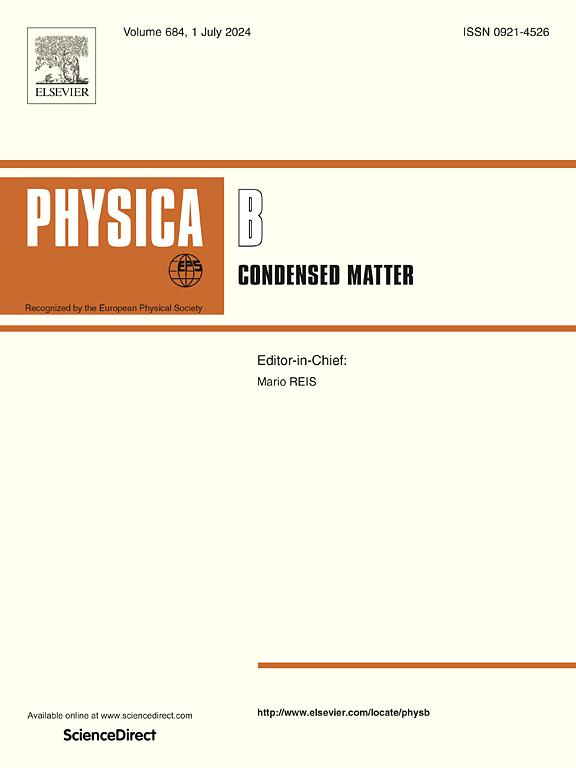RT and temperature-dependent dielectric behaviour of NiAl2O4-Effect of calcination temperature
IF 2.8
3区 物理与天体物理
Q2 PHYSICS, CONDENSED MATTER
引用次数: 0
Abstract
Sol gel auto-combustion was used to create nickel aluminate nanoparticles having the chemical composition NiAl2O4, which were then calcined at 700, 900, 1100, and 1300 °C for the present study. In order to evaluate the phase purity and validate the spinel structure and Fd3m space group of the prepared sample, the X-ray diffractometry result was examined at room temperature using the Rietveld refinement method. The LCR meter has been used to study dielectric properties such as the dielectric constant, tangent loss, and A.C. conductivity. The dielectric parameter, impedance, and A.C. conductivity changes were investigated as a function of temperature and frequency wherein temperature in the range 200–800 °C, and frequency in the range 1 Hz–10 MHz. The value of the dielectric constant was observed in the range 1.5⨯103–7.25⨯108 at room temperature and 2.8⨯107–1.6⨯109 at temperature span of 200 °C–800 °C. It has been found that the dielectric loss of produced aluminates decreased with the calcination temperature, hence, the sample calcined at 1300 °C would be a good choice for low loss applications. The semicircle character of the Cole-cole plots was exhibited by all the samples at room temperature and in the temperature range 200–800 °C. It has been found that the dielectric properties decrease with increasing frequency and temperature between 200 and 800 °C and Maxwell-Wagner interfacial polarization strongly supported these results.
NiAl2O4的RT和随温度变化的介电性能--煅烧温度的影响
本研究采用溶胶凝胶自动燃烧法生成化学成分为 NiAl2O4 的铝酸镍纳米粒子,然后在 700、900、1100 和 1300 °C 下进行煅烧。为了评估所制备样品的相纯度并验证其尖晶石结构和 Fd3m 空间群,在室温下使用里特维尔德精炼法检测了 X 射线衍射结果。利用 LCR 计研究了介电特性,如介电常数、正切损耗和 A.C. 电导率。研究了介电参数、阻抗和 A.C. 电导率随温度和频率的变化,其中温度范围为 200-800 ℃,频率范围为 1 Hz-10 MHz。在室温下,介电常数的观测值范围为 1.5⨯103-7.25⨯108,在温度跨度为 200 ℃-800 ℃时,介电常数的观测值范围为 2.8⨯107-1.6⨯109。研究发现,生成的铝酸盐的介电损耗随煅烧温度的升高而降低,因此,在 1300 °C 煅烧的样品将是低损耗应用的良好选择。在室温和 200-800 °C 温度范围内,所有样品的科尔-科尔图都呈现半圆形。研究发现,在 200 至 800 ℃ 之间,介电性能随着频率和温度的升高而降低,麦克斯韦尔-瓦格纳界面极化也有力地支持了这些结果。
本文章由计算机程序翻译,如有差异,请以英文原文为准。
求助全文
约1分钟内获得全文
求助全文
来源期刊

Physica B-condensed Matter
物理-物理:凝聚态物理
CiteScore
4.90
自引率
7.10%
发文量
703
审稿时长
44 days
期刊介绍:
Physica B: Condensed Matter comprises all condensed matter and material physics that involve theoretical, computational and experimental work.
Papers should contain further developments and a proper discussion on the physics of experimental or theoretical results in one of the following areas:
-Magnetism
-Materials physics
-Nanostructures and nanomaterials
-Optics and optical materials
-Quantum materials
-Semiconductors
-Strongly correlated systems
-Superconductivity
-Surfaces and interfaces
 求助内容:
求助内容: 应助结果提醒方式:
应助结果提醒方式:


